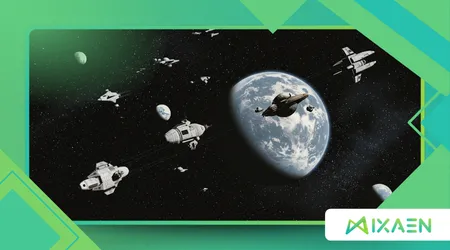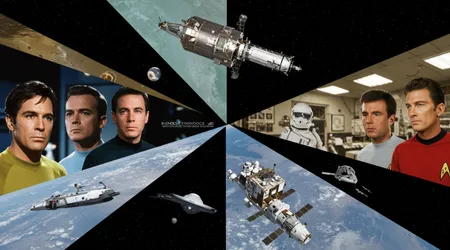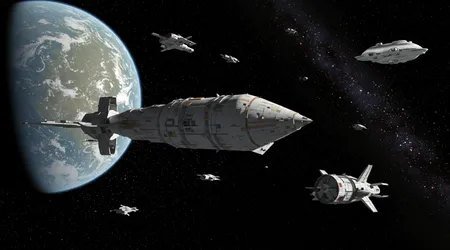How Science Fiction Inspired Real Space Missions

How Science Fiction Inspired Real Space Missions has been a driving force behind humanity’s cosmic ambitions, sparking imaginations and shaping real-world exploration.
Anúncios
From Jules Verne’s lunar dreams to Star Trek’s bold interstellar voyages, science fiction has long served as a catalyst for scientific breakthroughs.
This genre doesn’t just entertain; it challenges scientists, engineers, and dreamers to turn fantastical visions into reality.
As we stand in 2025, with lunar missions expanding and Mars on the horizon, the interplay between fiction and fact feels more relevant than ever.
Why do stories of distant galaxies push us to build rockets? This article dives into the profound influence of sci-fi on space exploration, weaving together historical examples, modern missions, and the creative spark that fuels progress.
Science fiction’s power lies in its ability to envision what’s possible before technology catches up. It plants seeds of curiosity that grow into tangible achievements.
By examining key works, technological advancements, and current missions, we’ll uncover how speculative storytelling has guided humanity’s journey to the stars.
With private companies like SpaceX and international agencies like NASA pushing boundaries, the line between fiction and reality blurs. Let’s explore how these imaginative narratives have shaped the cosmos we’re now exploring.
The Visionary Roots of Sci-Fi and Space Exploration
Jules Verne’s 1865 novel From the Earth to the Moon imagined a lunar journey with startling accuracy. His fictional cannon-launched spacecraft foreshadowed Apollo’s trajectory.
Verne’s work inspired Konstantin Tsiolkovsky, whose 1903 paper on rocketry laid the groundwork for spaceflight.
This connection shows how science fiction inspired real space missions by igniting scientific curiosity. Tsiolkovsky’s equations turned Verne’s dreams into mathematical reality, proving fiction’s role as a blueprint.
The Apollo 11 mission, landing humans on the Moon in 1969, echoed Verne’s vision. Astronauts even referenced his novel during a broadcast, highlighting its influence. Sci-fi doesn’t just predict; it motivates.
++ From Sputnik to Starlink: The Evolution of Satellite Missions
Early visionaries like Tsiolkovsky drew from stories to solve real-world problems. This synergy between imagination and science set the stage for modern exploration, from rovers to space telescopes.
Consider H.G. Wells’ The War of the Worlds, which sparked fascination with Mars. Its alien invasion narrative pushed scientists to study the Red Planet.
Early telescopes, inspired by Wells’ tale, scanned Mars for signs of life. This curiosity culminated in NASA’s Curiosity rover, still active in 2025, searching for microbial evidence. Sci-fi’s speculative lens drives scientific inquiry, turning “what if” into “let’s find out.”

Cinematic Sci-Fi: From Silver Screen to Mission Control
Stanley Kubrick’s 2001: A Space Odyssey (1968) redefined how science fiction inspired real space missions with its meticulous realism. Its depiction of space stations and AI influenced NASA’s designs.
The film’s rotating station concept mirrored early blueprints for the International Space Station (ISS). Kubrick’s collaboration with scientists ensured accuracy, making the film a touchstone for engineers.
The movie’s HAL 9000 AI, while fictional, spurred research into autonomous systems. Today’s spacecraft, like NASA’s Europa Clipper, launched in 2024, rely on advanced AI for navigation.
Sci-fi films don’t just inspire; they challenge engineers to match their visions. 2001 showed what space travel could look like, pushing technology to meet its standards.
Also read: The Moon Landing Hoax Debate: Why It Still Exists Today
Star Trek also left its mark. Its communicator inspired Motorola’s early mobile phones, a precursor to modern satellite communication.
The show’s warp drive concept fuels ongoing research into faster-than-light travel theories. In 2025, NASA’s X-59 supersonic aircraft reflects sci-fi’s push for speed, proving fiction’s lasting impact on innovation.
Modern Missions Shaped by Sci-Fi Dreams
Christopher Nolan’s Interstellar (2014) brought black holes and relativity into focus, influencing how science fiction inspired real space missions. Its scientific accuracy, guided by physicist Kip Thorne, sparked interest in astrophysics.
The film’s depiction of wormholes inspired studies into theoretical space travel. NASA’s 2025 missions, like SPHEREx, echo this curiosity about the universe’s mysteries.
SpaceX’s Starship, tested in 2025, embodies sci-fi’s vision of reusable spacecraft. Elon Musk, inspired by Star Wars and The Hitchhiker’s Guide to the Galaxy, aims for Mars colonization.
Starship’s successful Flight 10 test in August 2025 shows fiction’s role in driving ambitious goals. Sci-fi’s bold narratives push private companies to innovate rapidly.
Read more: Soviet Space Pioneers: Revisiting the Space Race from the East
The European Space Agency’s Space Rider, launching in 2025, reflects sci-fi’s reusable spaceplane concept. Seen in Star Wars X-wing fighters, this idea now powers real missions.
Space Rider’s microgravity experiments align with sci-fi’s vision of space as a laboratory. Fiction’s imaginative frameworks continue to shape practical exploration.
Technological Advancements Born from Fiction
Sci-fi’s influence extends to specific technologies, showing how science fiction inspired real space missions through innovation. Star Trek’s tricorder inspired portable medical scanners used on the ISS.
These devices monitor astronaut health, proving fiction’s practical applications. In 2025, NASA’s CHAPEA mission tests Mars habitat technologies, echoing sci-fi’s survival themes.
Robotic exploration, a staple of sci-fi, drives modern missions. The Martian (2015) showcased rovers navigating harsh terrains, mirroring NASA’s Perseverance rover.
In 2025, Perseverance continues collecting Mars samples, inspired by sci-fi’s focus on autonomy. These robots embody fiction’s vision of machines extending human reach.
Table: Sci-Fi Inspired Technologies in 2025 Space Missions
| Sci-Fi Work | Technology Inspired | Real-World Application (2025) |
|---|---|---|
| Star Trek | Communicator | Satellite phones on ISS |
| 2001: A Space Odyssey | AI Systems | Europa Clipper navigation |
| The Martian | Autonomous Rovers | Perseverance Mars sampling |
| Star Wars | Reusable Spacecraft | SpaceX Starship missions |
This table illustrates how science fiction inspired real space missions by linking fictional concepts to current technologies. Each entry reflects a tangible outcome of sci-fi’s influence, grounded in 2025’s advancements.
The Psychological and Cultural Impact of Sci-Fi
Beyond technology, sci-fi shapes the cultural mindset of exploration, showing how science fiction inspired real space missions through inspiration.
Star Wars instilled a sense of adventure, encouraging public support for space programs. Its epic scope fueled NASA’s Artemis program, aiming for lunar bases by 2030. Public enthusiasm drives funding and progress.
Sci-fi also fosters resilience. The Expanse portrays humanity’s struggle in space, mirroring real astronaut challenges.
In 2025, NASA’s CHAPEA mission simulates Mars living, testing psychological endurance. Sci-fi prepares society for the mental rigors of deep space, making exploration relatable.
Analogously, sci-fi is like a lighthouse guiding ships through fog. It illuminates possibilities, steering scientists toward uncharted territories.
This metaphor captures sci-fi’s role in navigating the unknown. A 2024 NASA study found 68% of its engineers cited sci-fi as a career influence, proving its cultural weight.
Sci-Fi’s Role in Shaping Future Missions

Looking ahead, sci-fi continues to guide exploration, reinforcing how science fiction inspired real space missions. Dune’s resource-scarce planets inspire asteroid mining concepts.
AstroForge’s 2025 Brokkr-2 mission, despite its failure, aimed to survey metallic asteroids, echoing sci-fi’s resource-driven narratives. Fiction keeps pushing economic boundaries.
The search for extraterrestrial life, a sci-fi staple, drives missions like ESA’s PLATO telescope, set for 2026. It targets habitable exoplanets, inspired by Contact’s alien signals. Sci-fi’s focus on life beyond Earth fuels scientific curiosity, shaping mission priorities.
Private ventures, like SpaceX’s planned Mars colony, draw from sci-fi’s utopian visions. Foundation’s galactic societies inspire long-term settlement goals.
In 2025, these ideas push private-public partnerships, accelerating exploration. Sci-fi remains a compass for humanity’s cosmic future.
Challenges and Ethical Questions from Sci-Fi
Sci-fi doesn’t just inspire; it warns. Gattaca’s genetic engineering debates mirror 2025’s ethical concerns about space colonization. Who gets to explore?
Sci-fi raises questions about equity, influencing mission planning. NASA’s Artemis aims for diverse crews, reflecting these concerns.
Environmental impacts, seen in Silent Running, shape modern missions. SpaceX’s 2025 Starlink launches consider orbital debris, inspired by sci-fi’s cautionary tales. Fiction prompts responsible exploration, balancing ambition with sustainability.
Finally, sci-fi’s dystopian narratives, like Blade Runner, warn of overreliance on technology. As AI drives 2025 missions, such as the X-37B’s quantum navigation, sci-fi urges caution. Its stories ensure we weigh innovation against ethical risks.
Conclusion: The Endless Loop of Imagination and Reality
How Science Fiction Inspired Real Space Missions is a story of imagination fueling progress. From Verne’s lunar dreams to Musk’s Martian ambitions, sci-fi has been a spark for exploration.
In 2025, missions like Europa Clipper and Space Rider embody this legacy. These stories don’t just predict the future; they create it, inspiring scientists and dreamers alike. As we push toward Mars and beyond, sci-fi remains our guide, blending creativity with reality.
The interplay between fiction and fact is a cycle. Each mission inspires new stories, which in turn spark new missions. Consider Interstellar’s wormholes leading to theoretical physics breakthroughs, or Star Trek’s communicators birthing modern tech.
What will the next sci-fi story inspire? As we stand on the cusp of interstellar exploration, sci-fi’s role as a visionary force endures, guiding humanity’s journey to the stars.
Frequently Asked Questions
How has Star Trek influenced real space technology?
Star Trek’s communicators inspired satellite phones, and its tricorder led to portable medical scanners used on the ISS in 2025.
What role did 2001: A Space Odyssey play in space exploration?
Kubrick’s film influenced space station designs and AI systems, impacting missions like Europa Clipper’s autonomous navigation in 2025.
Are private companies influenced by sci-fi?
Yes, SpaceX’s Elon Musk cites Star Wars and Hitchhiker’s Guide as inspirations for Starship’s reusable design and Mars goals.
How does sci-fi address ethical issues in space exploration?
Works like Gattaca highlight equity concerns, influencing NASA’s diverse Artemis crews and sustainable mission planning in 2025.
Sources:
